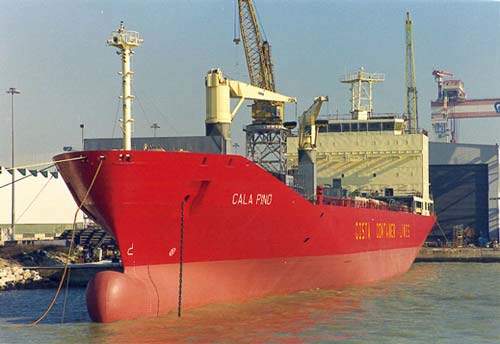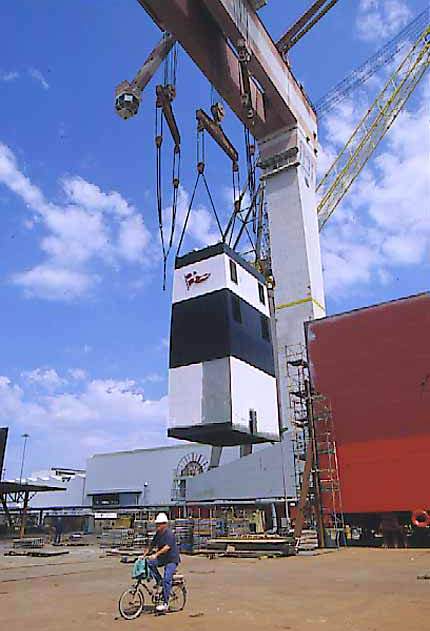The conventional reefer vessel Cala Pino was delivered to GF Invest subsidiary Armatori Partenopi in the second half of 1999. The 13,492dwt Cala Pino is one of four newbuildings ordered by the GF Invest group from Fincantieri’s Ancona yard.
Cala Pino flies the Netherlands Antilles flag and has Registro Italiano Navale classification.
DESIGN OF THE CALA PINO
The design of Cala Pino has been tailored to GF Invest’s traffic from Latin America and the Caribbean to its northern Italian hub port facilities. GF Invest has a dedicated terminal at Vado Ligure near Savona. The Reefer Terminal specialises in fruit and vegetable discharge, and the design of Cala Pino and her sisters reflects this trade, particularly in their advanced sideport cargo handling systems.
The cargo carrying area of the Cala Pino is divided in to three squared-off holds. These three holds are subdivided horizontally by three tweendecks. The resulting layout consists of 12 cargo compartments, each giving a minimum headroom of 2.23m above the gratings, thereby optimising stowage of trade-standard pallets of 1×1.2m.
The total storage area of 6,600m² enables the accommodation of approximately 4,900 fruit-bearing pallets in the three holds, separated by transverse bulkheads incorporating watertight, sliding doors to facilitate stevedoring operations.
Each of the three holds and its four subdivided cargo spaces encompasses two temperature zones, making for a total of six temperature zones throughout the cargo section. When bananas are transported, for example, the refrigeration arrangements enable the temperature of the loaded bananas to be brought down from 28°C to 13°C within a 24 hour period. A ductless ventilation system is employed, using fans dimensioned to give 90 air changes per hour.
Each reefer compartment on the Cala Pino has been prepared for the future adoption of controlled atmosphere (CA) technology. A CA environment delays the ripening process and lengthens the shelf-life of the product.
Wooden gratings have been used instead of aluminium ones, in accordance with the owner’s requirements. Timber was chosen to achieve the best wearing properties and should result in less noise generation during the working of the vessel in port than aluminium gratings would have.
PROPULSION
Cala Pino is powered by an eight-cylinder Sulzer RTA62U two-stroke diesel engine. The engine has been arranged for operation at 113rpm, on a maximum continuous rating of 24,160bhp, giving direct drive to a fixed pitch propeller.
The considerable electrical demands imposed upon the vessel by its refrigerated cargo are supplied by four aggregates. Each genset is comprised of a nine-cylinder Wärtsilä 20 engine, with an output rated at 1,395kW, coupled to a Marelli alternator.
Both the main engine and auxiliaries have been designed for operation on heavy fuel oil of 600cSt viscosity. Efficiency is also promoted by the use of a Sepa monitoring and control system, which includes power management of the gensets.
Ship handling has been improved by the inclusion of two tunnel thrusters, one forward and one aft. Each thruster provides around 950kW and is based on a controllable pitch propeller.
Contractual terms called for the vessel to demonstrate a speed of 21.3 knots on 8.1m design draught with the main machinery delivering 90% mcr during sea trials. Expectations were passed, promising speeds of as much as 23 knots during good weather, should the vessel need to make up time. Tank testing was carried out at the Vienna Model Basin, used by Fincantieri for a number of projects.





